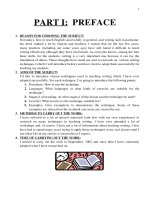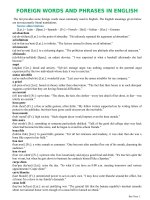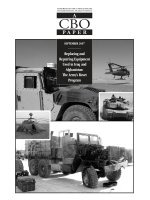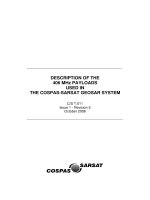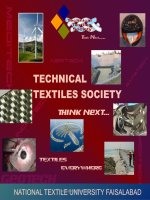Fibers used in making technical textile
Bạn đang xem bản rút gọn của tài liệu. Xem và tải ngay bản đầy đủ của tài liệu tại đây (262.46 KB, 20 trang )
F
i
b
e
r
s
U
s
e
d
i
n
m
a
k
i
n
g
t
e
c
h
n
i
c
a
l
t
e
x
t
i
l
e
Prepared by-
Md. Shariful Islam
2007100400001
Mithun Kumar Roy
2007100400011
MD. Shahriar Rabbani
2007100400012
MD. Touhidul Islam
2007100400033
MD. Kamal Hossain
2007100400040
MD. Sifath Bin Alam
2007100400044
Introduction:
•
A Technical textile is a textile product manufactured
for non-aesthetic purposes, where function is the
primary criterion. It is a large and growing sector and
supports a vast array of other industries.
•
. All fiber cannot be used to produce technical
textiles because of there mechanical and chemical
properties.
•
Some fibers have selected for making technical
textile for there special properties.
Objectives:
•
To know which fibers are used in making
technical textiles.
•
To know which properties allow them to be
used in producing technical textiles.
•
To know which fiber is used in producing
which technical textiles.
Descriptions:
•
The technical features of the fibers,
•
Image of there plants or production or
structure,
•
Which fibers are used in which technical
textiles are described below-
Cotton:
•
It is relatively heavy weight fiber, less resistant
to water, poor flame retardant. So the fiber is
not very attractive fiber.
•
But it is used in producing Hygiene and
medical products such as pad, bandage etc.
Flax & Jute:
•
These have low strength, residency but they
are biodegradable.
•
So they are widely used in agriculture and
geo-textiles.
Sisal:
It’s strength, durability, ability to stretch
allow it to use in dartboards, buffing cloth,
filters, geotextiles, mattresses, carpets,
handicrafts, wire rope cores etc.
Wool:
•
It has a good resistance to flame.
•
It is hardly used in isolating and as flame
retardant.
Silk:
•
It is a natural filament.
•
It is used in surgical suture threads.
Viscous Rayon:
•
It has high uniformity, tenacity, modulus,
absorbency & temperature resistance.
•
So it is widely used in surgery products, tire
cord, towels, diaper, driving belts & other
hygiene products.
Polyamide:
•
It has good strength, good abrasion
resistance, good elasticity, uniformity &
moisture resistance properties.
•
These properties allow it to use as climbing
ropes, parachute fabric & sails.
Polyester:
•
It has good strength, good abrasion
resistance, good elasticity, uniformity &
moisture resistance properties.
•
It is used in home furnishings, bed sheets, tire
reinforcements, fabrics for conveyor belts,
cushioning and insulating material in pillows &
many others.
Polypropylene:
•
It has low cost, low density, good abrasion
resistance, moisture resistance.
•
Very thin sheets of polypropylene are used as a
dielectric within certain high performance.
•
over 50% used
for diapers or sanitary products.
•
Used in water filters or air conditioning type filters.
•
Packing, carpet packing etc are also uses of
polypropylene.
Carbon fiber:
•
carbon fibers are polyacrylonitrile.
•
It is a high performance fiber. It’s uses shown
in the image-
Woven fabric made carbon fiber. Tail of a RC helicopter made from
carbon fiber.
Polybenzimidazole(PBI):
•
It has extremely high melting point & does not ignite
readily.
•
PBI is used to fabricate high-performance protective
apparel such as firefighter turnout coats and suits,
astronaut space suits, high temperature protective
gloves, welders' apparel, race driver suits, braided
pickings, and aircraft wall fabrics
High Modulus Polyethelene(HMPE):
•
It has extremely long chain, so it has a very good abrasion
resistance(15 times more than carbon steel), highest impact
strength, self-lubricating & non-toxic.
•
Used as body armor, vehicles armor, high-performance sails,
suspension lines, on sport parachutes and paragliders, high-
performance ropes for sailing and parasailing etc.
Aramide:
•
It is a heat-resistant and strong synthetic
fibers.
•
It is used in aerospace and military
applications, for ballistic rated body armor
fabric, firefighter’s dresses, in bicycle tires,
and as an asbestos substitute etc.
Polyether ether ketone (PEEK):
•
It is thermoplastic.
•
It is used in bearings, piston parts, pumps,
compressor plate valves, and cable insulation.
Polyphenylene sulfide(PPS):
•
PPS is one of the most important high
temperature polymers.
•
PPS is used to make filter fabric for coal
boilers, papermaking felts, electrical
insulation, specialty membranes, gaskets, and
packings.
Conclusion:
From this presentation we have seen
that there are some fibers using in high
performance technology. That means textile is
developing & enlarging it’s fields.
